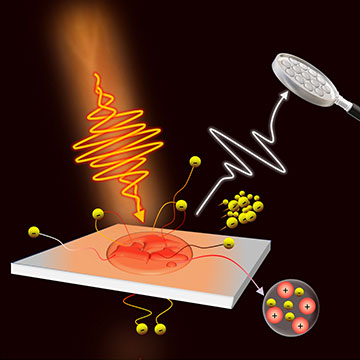
An intense laser pulse focused on a solid target drives inhomogeneous plasma dynamics, affecting the spatiotemporal profile of the reflected light. [Image: Ankit Dulat]
A new field, plasma optics, has emerged in the last two decades, stemming from the ever-increasing intensity of ultrashort-pulse lasers. Conventional optical elements, with an upper threshold of less than 1 J/cm2, are unable to withstand such high-intensity light pulses without damage. Since matter in a plasma state is already broken down, optical elements based on plasma offer a compelling solution for manipulating laser light.
Now, researchers at the Tata Institute of Fundamental Research (TIFR) in India have reportedly developed an all-optical method for the 3D spatiotemporal characterization of femtosecond pulses interacting with relativistic hot-dense plasma (Optica, doi: 10.1364/OPTICA.522870). This single-shot measurement has the ability to measure any distortions caused by the plasma on the spatiotemporal structure of the pulses. In addition, even for non-plasma applications, it represents a straightforward way of checking the temporal profiles of pulses at different points across the spatial profile.
A series of realizations
G. Ravindra Kumar and his colleagues had previously studied ultrafast dynamics in high-energy-density plasmas in only one dimension, using pump–probe techniques. In recent years, they began following these dynamics along the two-dimensional surface of the plasma using a specially designed Doppler spectrometer. The method allowed for the observation of femtosecond dynamics simultaneously at different spatial points across the plasma surface.
They realized that the same spectrometer could be leveraged to perform spectral interferometry to obtain phase dynamics across the transverse profile of the plasma. Spectral interferometry is a powerful technique for measuring the intensity and phase of optical pulses. Two pulses—one with a known time delay—are interferometrically combined, and the optical spectrum of that combination is recorded.
“Then came the insight that [spectral interferometry] could be used to measure femtosecond pulse temporal profiles across the 2D beam profile,” said study author Kumar. “We did test measurements on normal optical elements to demonstrate that this method would actually give us the information on the light pulse itself.”
Just one shot
The researchers merged spectral interferometry with the pump–probe technique expanded to two spatial dimensions, which allowed them to capture 3D information (two spatial dimensions plus one spectrum) to characterize laser pulses, all in a single shot. The measurement device they used consists of a lenslet array and a fiber array coupled with a stack of 16 individual spectrometers.
The scientists used the lens array to sample the spatial profiles of an unknown pulse as well as a time-delayed, well-defined reference pulse. The lens array focuses distinct spatial segments of light onto a fiber array, which then couples light to the spectrometers. The reference pulse is derived from each laser shot itself, which implies that shot-to-shot fluctuations do not have an impact on the measurement.
After successful testing on conventional optical elements, Kumar and his colleagues used their all-optical measurement scheme to investigate the in situ interaction dynamics of a relativistic laser pulse with solid-density plasma.
After successful testing on conventional optical elements, Kumar and his colleagues used their all-optical measurement scheme to investigate the in situ interaction dynamics of a relativistic laser pulse with solid-density plasma.
“We looked at the reflected pulses from the high-energy-density plasma induced by a femtosecond, high-intensity laser,” he said. “These plasmas can be highly hot and turbulent, and we were able to capture the temporal profiles across the plasma surface as the plasma evolved with time.”
From metrology to plasma optics
Kumar sees a number of applications for this technique, from femtosecond-pulse metrology to plasma optics. Researchers in spectroscopy, chemistry and biology will be able to obtain more-detailed knowledge about lasers in their experimental setups. And such information is even more crucial for ultrahigh-power femtosecond facilities, like Europe’s Extreme Light Infrastructure.
“Plasmas will spur the growth of [the] future of high-intensity optics, and they inevitably produce a high level of modulation in pulse profiles across the reflecting area,” Kumar said. “Ultrahigh-power laser technology and plasma physics will need to have such information.”
